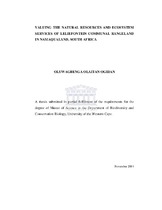| dc.description.abstract | Natural resources play important roles in ecosystem service delivery, more especially in rural households where livelihoods depend heavily on natural resources for the delivery of ecosystem services. The various benefits derived from provisioning, supporting, regulating and cultural services of natural ecosystems such as food, medicines, carbon sequestration, spiritual fulfilment all support human life and sustain its well-being. Research on valuation of natural resources suggest that the values derived mainly from non-marketed natural resources are insignificant and thus, not reflected in national accounts. Economic valuations have traditionally been concerned with the quantification of direct use values of ecosystem services that are marketed to produce tangible benefits. The scope of natural resource valuations have, however been broadened by scientists in recent years to consider passive or non-use values to reflect the total economic values of natural resources and ecosystem services to societies. In this study, I valued the streams of ecosystem services derived from natural resources in Leliefontein communal rangeland; an area of 192 000 hectares in the semi-arid region of Namaqualand in South Africa. Rangeland forage for livestock, medicinal plants, fuelwood, and water resources from the Communal Area were valuated for one production year between January and December 2012. Valuation was done to incorporate both marketed and non-marketed natural resources which were used within the production year. The total economic value for the area was estimated at R20 156 672 per annum. Value of rangeland forage was estimated at R61.92 ha-1 yr-1, fuelwood’s value was estimated at R25.04 ha-1 yr-1, value of medicinal plants was R2.26 ha-1 yr-1 and water resources valued at R9.45 ha-1 yr-1. The non-use value was estimated by eliciting the willingness to pay for the conservation of the natural resources using a contingent valuation method. Economic value of natural resources in Leliefontein increased to R105 per hectare from R99 when non-use value was added to reflect the total economic value of ecosystem services in the area. Household income level positively correlated with individual’s willingness to pay for ecosystem services. I recommend that decision making should take into account the socio-economic conditions of a community when determining the total economic value of ecosystem services. Non-use value of the ecosystems should be considered especially in rural areas where people depend on the natural environment for livelihoods and socio-cultural well-being. Sustainable and equitable utilisation of natural resources for the purpose of maintaining a sustainable flow of critical ecosystem services should form the basis for formulating policies on land use and sustainable development. | en_US |

